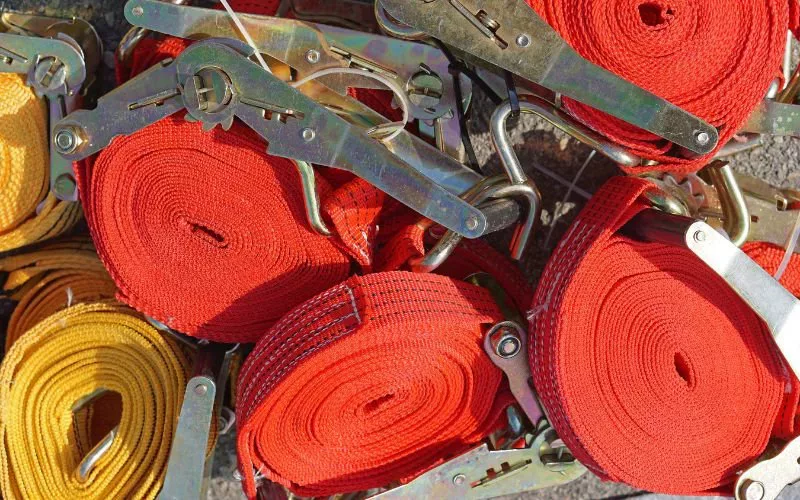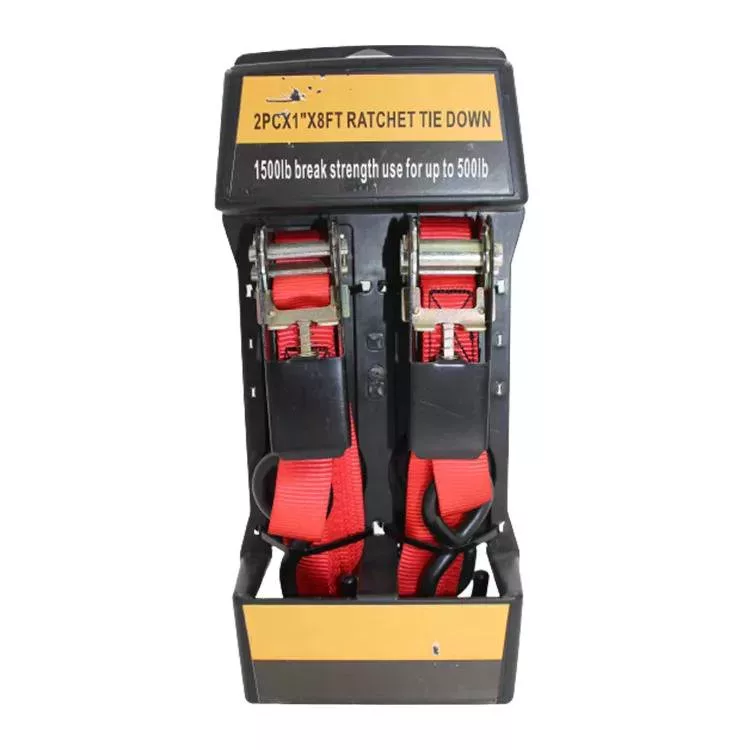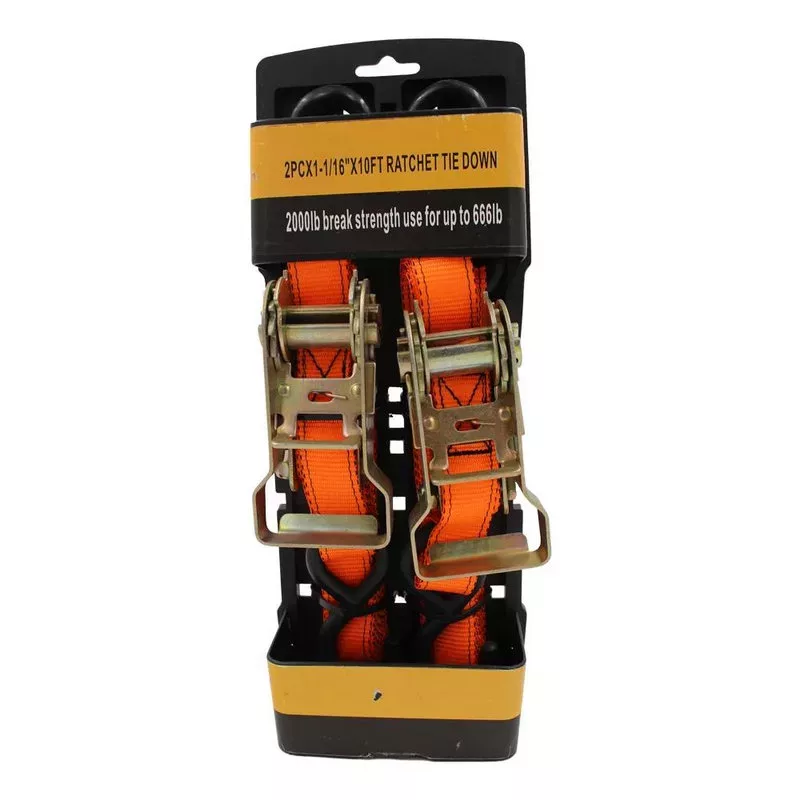The Common Length of Ratchet Straps in Use
When selecting ratchet straps for securing your load, it’s crucial to choose an appropriate length. The most widely used lengths of ratchet straps are typically:
- 10 feet
- 15 feet
- 20 feet
- 30 feet
However, the optimal length for your needs depends on the size and shape of your cargo. The general guidance suggests that your ratchet straps should be at least 1.5 times the length of the item you’re securing. This ensures you have sufficient strap to not only reach across the item but also to loop back and ensure a tight, secure fit without any slack.
For everyday use, such as securing a small load in a pickup truck bed, 10-foot straps are a common choice. On the other hand, 15-foot straps provide a bit more versatility without being excessively long for most standard applications. These are comfortable choices if you need to secure items like furniture or a small amount of building material.
For larger items such as vehicles, machinery, or larger construction goods, 20 to 30-foot straps are frequently pursued. They give you the length needed to cover massive items and are often used in professional settings like transport and logistics.
What to Consider for Choosing the Best Length of Ratchet Straps

Selecting the ideal length for your ratchet straps is crucial to ensure the security of your cargo during transport. Here are the main factors you should consider.
Measure Cargo’s Dimensions
Before purchasing ratchet straps, accurately measure the length, width, and height of your cargo. This will guide you on the minimum strap length needed to secure the load. For instance, if your cargo’s perimeter is 10 feet, you’ll need straps that are longer than 10 feet to accommodate proper tensioning.
Specify the Exact Number of Tie-Down Points
Examine your trailer or vehicle for designated tie-down points. The number of anchor points influences the number and length of ratchet straps you’ll require. For every tie-down point, ensure you have enough strap length to reach and secure the load, with some additional length for adjustability.
Consider the Type of Vehicle and Trailer
The type of vehicle and trailer you’re using dictates the lengths and types of straps best suited for your needs. Longer trailers might necessitate longer straps, especially if you need to reach over large or oddly shaped items. Make sure to match your ratchet straps with the capabilities of your vehicle and trailer.
Bear Safety in Mind
Safety should always be a priority when determining the length of your ratchet straps. Using straps that are too short could compromise the security of the load, while excessively long straps may lead to unwanted slack or tangling. Consider both the minimum and maximum required lengths that allow for safe transport and secure anchoring of your cargo.
The Relationship Between Cargo Weight and Length of Ratchet Straps
Actually, when choosing ratchet straps, the length should be selected based on having sufficient length to secure your load, while the width and construction quality determine the all-important Working Load Limit and Break Strength you need for your specific load weight and tie-down requirements. The strength ratings are independent of the strap’s length itself.
Therefore, we’ll provide you with different weight limits based on both the length of the ratchet straps and their width for your reference.
Weight Range the 8-Foot Ratchet Straps can Handle
An 8-foot ratchet strap is suitable for light-duty purposes. Perfect for securing:
The following table summarizes the working load limits (WLL) and breaking strengths for common 8-foot ratchet strap sizes:
| Strap Width | Working Load Limit (WLL) | Breaking Strength |
|---|---|---|
| 1 inch | 300 – 1,100 lbs | 900 – 1,823 lbs |
| 1.5 inch | – | 3,328 – 5,208 lbs |
| 1.6 inch | 1,736 – 2,600 lbs | 5,208 lbs |
| 2 inch | 915 – 3,333 lbs | 10,000 – 12,000 lbs |

Weight Range the 10-Foot Ratchet Straps can Handle
10-foot ratchet straps are versatile, typically used for medium-weight items. Ideal for:
The following table summarizes the typical weight ranges that 10-foot ratchet straps can handle for different strap widths:
| Strap Width | Working Load Limit (WLL) | Breaking Strength |
|---|---|---|
| 1 inch | 500 – 1,000 lbs | 1,500 – 3,000 lbs |
| 1.5 inch | 1,000 lbs | 3,300 lbs |
| 2 inch | 1,100 – 3,333 lbs | 10,000 – 12,000 lbs |

Weight Range the 15-Foot Ratchet Straps can Handle
When it comes to securing larger cargo, 15-foot ratchet straps are a reliable choice. They handle:
- Larger appliances
- ATVs
- Weights firmly in the 1,000 to 2,000-pound range
The following table summarizes the typical weight ranges that 15-foot ratchet straps can handle for different strap widths:
| Strap Width | Working Load Limit (WLL) | Breaking Strength |
|---|---|---|
| 1 inch | 500 – 1,666 lbs | 1,500 – 5,000 lbs |
| 1.5 inch | 1,333 lbs | – |
| 2 inch | 2,500 – 4,500 lbs | 7,500 – 13,500 lbs |

Weight Range the 27-Foot Ratchet Straps can Handle
For the heaviest loads, 27-foot ratchet straps are the go-to. These heavy-duty straps are ideal for:
- Large vehicles
- Heavy equipment
The following table summarizes the typical weight ranges that 27-foot ratchet straps can handle for different strap widths:
| Strap Width | Working Load Limit (WLL) | Breaking Strength |
|---|---|---|
| 1 inch | – | 1,500 – 5,000 lbs |
| 1.5 inch | 3,333 lbs | 10,000 lbs |
| 2 inch | 3,300 – 3,335 lbs | 10,000 – 13,500 lbs |
How to Use Ratchet Straps in Different Lengths

Using ratchet straps effectively depends on selecting the right length for your specific securing needs, whether you’re tethering cargo to a trailer, roof rack, motorcycle, or in a truck bed. Different lengths provide versatility for various load sizes, but it’s crucial to know how to handle them correctly to maintain safety and efficiency.
How to Thread Ratchet Straps in Different Lengths
For 8-foot Ratchet Straps:
1. Locate the webbing feed slot on the ratchet mechanism and feed the strap webbing through it from the underside.
2. Pull about 18-24 inches of webbing through the feed slot.
3. Route the webbing over the top of the spool/mandrel and under the take-up spool.
4. Take 2-4 wraps of webbing around the spool in a clockwise direction, keeping the webbing flat and neat.
5. Feed the webbing back through the slot below the spool to complete the threading.
For 10-foot and 15-foot Ratchet Straps:
The process is similar, but you’ll need to pull more webbing (3-4 feet) through initially to have enough length to wrap around the spool 2-4 times.
1. Feed webbing through the feed slot from underside.
2. Pull 3-4 feet of webbing through and over the spool.
3. Take 2-4 wraps of webbing clockwise around the spool.
4. Feed webbing back through the slot to complete.
For Longer 27-foot Straps:
These may require two people – one to feed webbing through while the other takes wraps around the spool.
1. Feed 6-8 feet of webbing through the slot initially.
2. Wrap that length 2-4 times clockwise around the spool.
3. Feed the remaining webbing back through the slot.
The key things to remember are feeding from the underside, taking 2-4 neat wraps around the spool, and feeding the webbing back through the slot to complete. Proper threading is crucial for effective ratcheting and avoiding webbing jams.
How to Loosen Ratchet Straps in Different Lengths
For 8-foot Ratchet Straps:
1. Release the locking pawl or lever that engages the ratchet gear teeth. This will allow the spool to spin freely.
2. While holding the ratchet mechanism with one hand, use your other hand to pull out the webbing strap to introduce slack.
3. Once enough slack is created, you can fully unwrap the webbing from around the spool by pulling it through the feed slot.
For 10-foot and 15-foot Ratchet Straps:
1. Release the locking pawl/lever to disengage the ratchet gear.
2. Pull out several feet of webbing strap to create sufficient slack.
3. Unwrap the 2-4 wraps of webbing from around the spool while continuing to pull out more webbing length.
4. Feed the unwrapped webbing back through the feed slot.
For Longer 27-foot Straps:
1. Release the locking pawl and pull out 6-8 feet of webbing to create slack.
2. Have a second person unwrap the 2-4 wraps from the spool while you continue pulling out more webbing.
3. Once fully unwrapped, feed the webbing back through the slot.
General Tips:
- Never force the spool to spin backwards against the locking pawl – this can damage the ratchet mechanism.
- For stubborn straps, you may need to relieve tension by loosening both ends before unwrapping.
- Proper loosening prevents webbing tangles and jams in the mechanism.
- Always inspect straps for wear or damage after loosening before re-use.
The key is creating sufficient slack, unwrapping webbing from the spool, and feeding it back through the slot in a controlled manner for straps of all lengths.
Ratchet Strap Protection & Storage
When maintaining the integrity of your ratchet straps, proper storage is key to preserving their strength and ensuring they are safe to use when needed. Before storing, conduct a thorough inspection of the webbing for signs of wear, cuts, or contamination from oils or chemicals which may compromise the strap’s integrity.
Cleaning and Drying
- Rinse your straps using a hose to remove loose dirt.
- Scrub with a mild detergent and warm water if needed.
- Air dry completely before storage to prevent mildew.
Storage Guidelines
- Hang straps from a hook in a clean, dry area to avoid creases or damage.
- Store away from direct sunlight as UV rays can weaken the webbing over time.
- Place in an environment with consistent temperature and humidity levels to prevent corrosion of any metal components.
Regular Care
- Lubricate ratchet mechanisms with a silicon-based spray to fend off rust.
- Ensure weather-resistant features of the strap are intact.
- Rotate straps in storage to ensure even use and maintain durability.
Taking these steps to care for your ratchet straps will prolong their life and maintain their reliability for securing your cargo.
